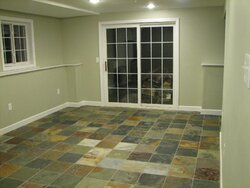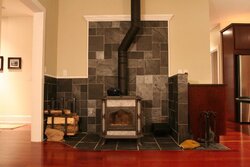Thats a tough one. It depends on the type of surface. Is it tile, stone, or slate?
I'm gonna guess it's a natural stone to match your Heritage.
First a little info: The grout is a cement based product designed to fill gaps and bond to the edges of the stone. Part of the strength in the bond is from part of the grout actually getting absorbed into the pores of the stone itself. When grouting, we clean the surface of the stone to remove any wanted grout before it completes this bond. When residue is left in place on ceramic tile, it's no problem because the glaze is impervious to any absorption of the grout and removes easily. It stays stuck to the edges of the tile becouse there is no glazing. Stone does not have glazing, and is much mor porous, and the pores are fairly large, so it has a tendency to hold the grout residue.
The other problem is that natuaral stone is very acid sensitive when compared to ceramic tile (however you can still damage ceramic tile with acids). If this is a polished stone then your in trouble. But, I'm gonna guess that it is not polished. If it is a rough or honed finish, or even a smooth satin finish, then you in pretty good shape becouse acid will remove any shine on a polished stone instantly, but will not really eat up the stone (within reason).
If this was my stone (and I have done this before on my own stone), I would contact my local ceramic tile distributor and look for a PHOSPHORIC acid based tile and grout cleaner. The reason I stress PHOSPHORIC acid is this. All acids can harm your stone and grout. PHOSPHORIC acid has been found to harm the stone and grout the LEAST (this is according to the tile and grout industry). DO NOT USE MURATIC ACID ON ANY TILE, STONE, SLATE, GROUT, OR WHATEVER! You don't know how much money muratic acid has made for me from joe blow using it to clean grout and ended up damaging the tile! Besides the phosphoric, you will need a 3-M scrub pad and a stiff nylon brush. The tile distributor should have these, if not, stop at an automotive paint supply store and get the brown 3-m scrub pads, and any type of scrub brush you use for cleaning your hands after an oil change or something would work.
Soak the stone with water. What I mean is get a bucket with water and a rag. Wipe it all down with water. Let the water stand. Keep doing this for an hour or two. You want the stone to absorb as much water as possible so that it will not absorb any of the acid solution (putting the acid on a dry stone will get sucked into the stone and cause it to breakdown over long term).
Once you did the water thing, dry the surface and let the surface get dry to touch. Also the surface should be at room temp. Now, in an inconspicous area, try to clean a spot of the residue with the cleaner and the scrub pad. It may come off right away, or you may need to let it sit for a few minutes. Let the acid soften the grout residue, and use the scrub pad to help it along. Hopefully this removes it. Once it looks like it is gone, rinse it twice with water and let the area dry then check for damage to the stone. If no damage, continue. If you have damage (I doubt it as the concentration of phosporic acid in the cleaners is only about 10%), stop and let me know.
Do not let the acid dry on the surface, and you need to rinse with water at least twice when all done. Also use the scrub brush when rinsing becouse acids have a tendency to "cling" to surfaces and need agitation to remove it. Also change your rinse water often. If everything looks good, then wash one more time with a touch of dish soap (not dishwasher soap) in water, let dry for a week or two, then seal it as mentioned in my earlier post. Use common sense, protect other surfaces, open a window, wear gloves, read labels, etc. This is not a miracle worker, but will work good for mild residue. The problem is stone can be damaged easily and there are less choices of acids to use than with ceramic tile.
Here is a link to the product I am most familiar with:
http://www.aquamix.com/for_professionals/products/pg_detail.asp?pdid=44159&pgid=9833
It is a very complete product line, sold thru tile distributors. Great resource for problem solving. Take the time to do your homework on their website. Here is a link to find a dealer:
http://www.aquamix.com/where_to_buy/
Here is their line of sealers, I personaly like the Ultra-solve:
http://www.aquamix.com/for_professionals/products/product_group.asp?pgID=37155
Here is the grout release product I mentioned earlier:
http://www.aquamix.com/for_professionals/products/pg_detail.asp?pdid=26171&pgid=9833
Man, I just wrote a book! Hope this helps, KD




